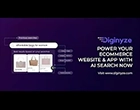Table Of Content
Introduction Optimize Your Website for SEO Prioritize User Experience (UX) for Higher Conversions Leverage Social Media and Influencer Marketing Implement Affiliate Marketing for Passive Growth Offer Multiple Payment and Checkout Options Master the Art of Customer Service and Retention Use Email and SMS Marketing for Personalized Engagement Evolve with Shifting Customer Preferences and Market Trends Expand Through Multi-Channel Selling and Partnerships Innovate and Diversify Product Offerings Conclusion FAQs
Introduction
The eCommerce industry is booming like never before. With global eCommerce sales projected to reach $7.4 trillion by the end of 2025, businesses must adopt the right strategies to stay ahead in this competitive market. Achieving success in eCommerce goes beyond simply launching a store it requires strategic, data-backed approaches to enhance conversion rates, elevate customer experiences, and fine-tune marketing strategies.
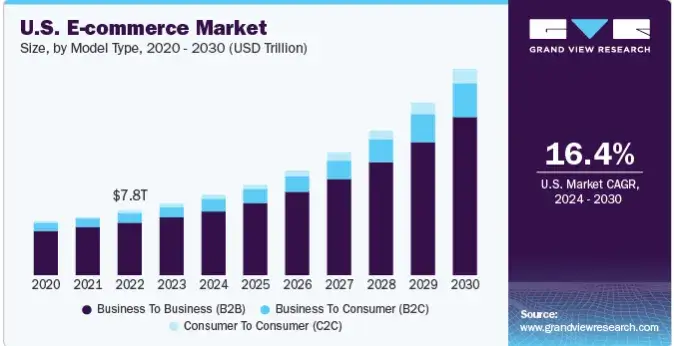
Source - grandviewresearch
This blog will explore 10 proven strategies for eCommerce success, equipping you with actionable insights to thrive in the ever-evolving digital marketplace.
1. Optimize Your Website for SEO
Why it matters : Around 68% of online experiences start with a search engine. Higher rankings on Google mean more organic traffic, which leads to increased sales.
Impact : Without SEO, even the best eCommerce store may struggle to get noticed, reducing potential conversions.
Key SEO Tactics:
- Keyword Optimization : Identifying high-intent keywords (e.g., best running shoes for women) ensures your product pages and blogs rank for relevant searches.
- Site Speed : Even a one-second slowdown can lead to a 7% decrease in conversions. You can boost site performance by compressing images, cleaning up excess code, and leveraging content delivery networks (CDNs).
- Mobile-Friendliness : Over 60% of eCommerce traffic comes from mobile devices, making responsive design crucial.
On-Page vs. Off-Page SEO Strategies:
- On-Page SEO : Involves optimizing elements within your website, such as title tags, meta descriptions, structured data, and internal linking.
- Off-Page SEO : Focuses on external factors like backlink building, social signals, and influencer collaborations to increase domain authority.
A well-optimized website ranks higher, loads faster, and attracts more customers. By leveraging both on-page and off-page SEO strategies, businesses can attract consistent organic traffic and enhance their long-term eCommerce performance.
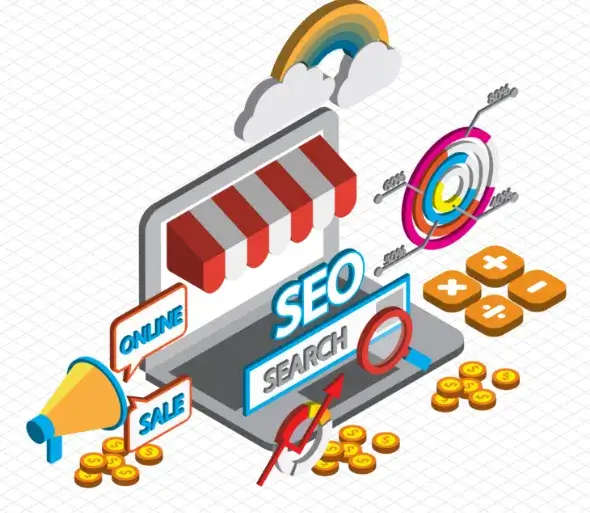
2. Prioritize User Experience (UX) for Higher Conversions
1. How Site Speed, User-Friendly Navigation, and Mobile Optimization Influence Performance:
- Navigation : Clear menus, well-structured categories, and intuitive search functions make it easier for customers to find what they need.
- Mobile Optimization : With over 60% of eCommerce traffic coming from mobile devices, having a responsive design is crucial for better engagement and sales.
2. How to Simplify the Checkout Process:
- Reduce the number of steps in checkout.
- Offer guest checkout to avoid unnecessary account creation.
- Enable auto-filled shipping and payment details for faster transactions.
- Provide multiple payment options (credit cards, PayPal, BNPL).
3. The Role of AI in Enhancing UX:
- Personalized recommendations using AI-driven analytics boost sales by suggesting relevant products.
- AI chatbots and virtual assistants offer real-time support, helping minimize customer abandonment and enhancing overall user engagement.
- Smart search and voice search integration improve product discovery.
A seamless UX improves engagement, reduces cart abandonment, and increases conversions. AI-powered personalization and a frictionless checkout process are key to eCommerce success.
Also Read : 5 eCommerce User Experience Trends
3. Leverage Social Media and Influencer Marketing
Social commerce is rapidly expanding, with sales influenced by social media expected to reach $2.9 trillion by 2026.

Best Platforms for eCommerce Businesses:
- Facebook and Instagram : Ideal for product discovery, targeted ads, and direct shopping via Instagram Shops.
- TikTok : Engages younger audiences with viral product trends and TikTok Shopping integration.
- Pinterest : Drives high-intent traffic with shoppable pins.
- YouTube : Great for product reviews, unboxings, and tutorials.
Social media is a powerful tool for driving eCommerce sales through influencer marketing, direct shopping integrations, and engaging content. Businesses that leverage these platforms effectively can boost brand awareness and conversions.

Source – statista
4. Implement Affiliate Marketing for Passive Growth
Affiliate marketing contributes to approximately 16% of total eCommerce revenue.
How to Leverage Affiliate Marketing:
- Partner with relevant influencers and content creators.
- Offer an attractive commission structure.
- Use affiliate tracking software to measure ROI.
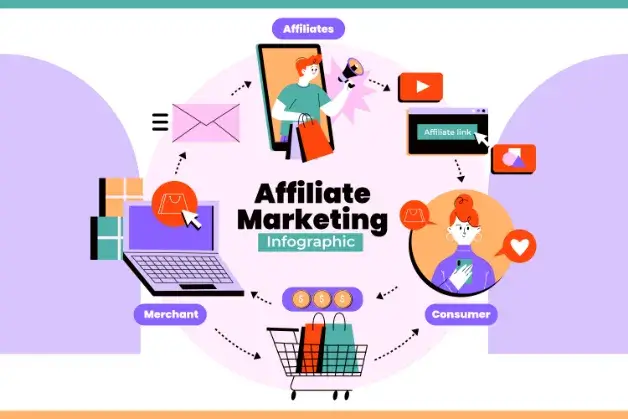
Offer Multiple Payment and Checkout Options
1. The Importance of Flexible Payment Methods:
- Offering diverse payment options caters to different customer preferences, increasing the likelihood of completed purchases.
- 56% of online shoppers abandon carts if their preferred payment method isn't available.
Also Read : - eCommerce Payment Trends You Can’t Ignore
2. Buy-Now-Pay-Later (BNPL) and Digital Wallets:
- BNPL options (Afterpay, Klarna, Affirm) allow customers to split payments, making high-ticket items more accessible.
- Digital wallets (PayPal, Apple Pay, Google Pay) speed up checkout, reducing friction for mobile shoppers.
3. How Seamless Transactions Reduce Cart Abandonment:
- Streamlined one-click checkout simplifies the purchase process, making shopping faster and more convenient for customers.
- Auto-filled payment and shipping details streamline the process.
- Secure, hassle-free transactions boost trust and encourage repeat purchases.
Providing multiple payment options enhances customer convenience, reduces friction, and increases conversions, making it a crucial strategy for eCommerce success.
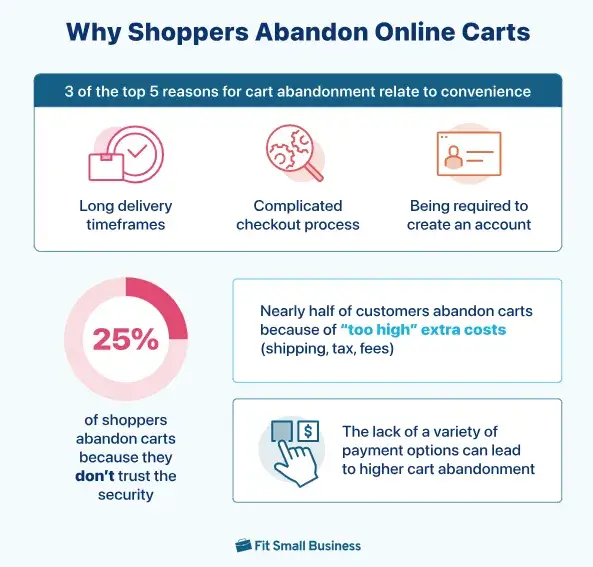
Source – fitsmallbusiness
Also read - Cart Abandonment - How to Win the Checkout Game
6. Master the Art of Customer Service and Retention
1. Why Retention Matters:
- Acquiring a new customer costs 5X more than retaining one.
- Repeat customers spend 67% more than new ones, making retention a key growth strategy.
2. Retention Strategies:
- AI Chatbots for Instant Support: Provide 24/7 customer assistance, answer FAQs, and improve response times.
- Personalized Discounts and Loyalty Programs: Reward repeat customers with exclusive offers, discounts, and VIP perks to encourage long term engagement.
- Hassle Free Returns and Fast Shipping: Easy return policies and quick delivery boost customer trust and encourage future purchases.
Exceptional customer service and smart retention strategies increase customer loyalty, reduce churn, and drive sustainable eCommerce success.
Bonus Tip - How AI can Reduce Customer Churn
7. Use Email and SMS Marketing for Personalized Engagement
Email and SMS marketing are powerful tools for driving customer engagement and conversions. Research shows that email marketing delivers an impressive return, earning about $42 for every dollar invested ranking it among the most cost-effective marketing tactics.
The Importance of Email and SMS Campaigns in Driving eCommerce Growth
- Direct and Personalized Communication: Customers are more likely to engage with messages tailored to their interests.
- Higher Open and Conversion Rates: Emails have an average open rate of 21.33%, while SMS messages boast an open rate of 98%.
- Cost-Effective and Scalable: Automated campaigns reach thousands of customers at a fraction of the cost of paid ads.
Effective Email and SMS Strategies for eCommerce
1. Use Automation for Cart Abandonment Reminders
- Why it’s important : Nearly 70% of online shopping carts are abandoned.
- How it works : Set up automated emails/SMS to remind customers about their abandoned items, often with an incentive (e.g., a discount or free shipping).
- Effectiveness : Businesses that utilize cart recovery emails typically recover 10–15% of abandoned sales through conversions.
2. Personalize Emails Based on Browsing Behavior
- Why it’s effective : Personalized emails result in 6X higher transaction rates than generic ones (Experian).
- How to do it:
- Send product recommendations based on past searches or purchases.
- Use dynamic content (e.g., "Hey [First Name], we think you’ll love these new arrivals!").
- Offer exclusive deals on previously viewed items.
- Example : Amazon and Shopify stores use AI-powered segmentation to send highly relevant product suggestions.
3. Send SMS Promotions for Time-Sensitive Offers
- Why SMS? SMS messaging sees a response rate of around 45%, significantly higher than the 6% average for email.
- Best use cases:
- Flash sales and limited-time discounts.
- Order confirmations and shipping updates.
- Personalized discount codes for loyal customers.
- Example : An SMS saying, “Flash Sale! 20% off sitewide for the next 3 hours. Tap to shop now!” creates urgency and immediate action.
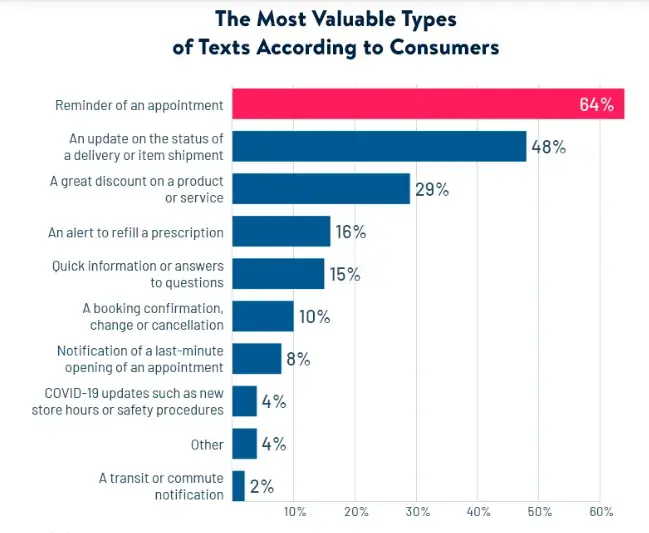
Source -99firms
Email and SMS marketing are essential for driving repeat sales, reducing cart abandonment, and creating personalized shopping experiences. eCommerce brands can greatly enhance customer engagement and drive more conversions by using automation, personalized content, and well-timed communications.
8. Evolve with Shifting Customer Preferences and Market Trends
Consumer preferences are constantly evolving, and businesses that fail to adapt risk losing customers to more agile competitors. According to market research, 78% of shoppers now prioritize value for money, showing a shift toward budget-conscious shopping, convenience, and sustainability.
To stay ahead, eCommerce businesses must analyze market trends, adjust pricing, and offer relevant products that align with current consumer demands.
Adapting Quickly in an Evolving Marketplace
1. Monitor Buying Patterns and Adjust Pricing Strategies
- Why it’s important: Consumer spending habits fluctuate based on economic conditions, seasonal trends, and global events.
- How to do it
- Analyze customer purchase data to identify trends (e.g., increased demand for discounts during inflationary periods).
- Implement dynamic pricing adjust prices based on demand, competitor pricing, and purchasing trends.
- Offer bundled discounts, loyalty rewards, and flexible pricing options to appeal to price-sensitive shoppers.
- Example: Amazon leverages AI-powered dynamic pricing, frequently updating product prices throughout the day to maintain a competitive edge.
2. Use AI Analytics to Forecast Demand and Stock Inventory Accordingly
- Why it’s effective : Overstocking leads to financial losses, while understocking causes missed sales opportunities.
- How AI helps :
- Predict future demand based on historical sales data and market trends.
- Automate inventory restocking to prevent shortages.
- Identify which products are declining in demand and adjust marketing efforts accordingly.
- Example : Retail giants like Walmart and Zara use AI-powered analytics to optimize inventory management and avoid excess stock.
3. Offer Sustainable and Eco-Friendly Product Options
- Why it matters : 73% of consumers prefer brands that prioritize sustainability.
- How to implement :
- Use eco-friendly packaging and promote your sustainability efforts.
- Promote sustainably made products or emphasize eco-friendly shipping options, such as carbon-neutral delivery.
- Partner with organizations supporting environmental causes to build brand trust.
- Example : Brands like Patagonia and Allbirds successfully market their eco-conscious products, attracting environmentally aware customers.
The key to eCommerce success lies in adapting to consumer behaviors by using data-driven insights, AI-powered forecasting, and sustainability initiatives. Businesses that stay agile and prioritize what customers truly value will increase customer loyalty, sales, and long-term profitability.
Read also : Augmented Reality – A Fast-Growing Trend in eCommerce
9. Expand Through Multi-Channel Selling and Partnerships
In today’s competitive eCommerce landscape, relying solely on your website limits growth opportunities. Selling on multiple platforms increases brand exposure, attracts new customers, and diversifies revenue streams. According to Statista, 56% of online shoppers start their product searches on marketplaces like Amazon and eBay, proving that multi-channel selling is essential for scaling an eCommerce business.
Why Multi-Channel Selling is Crucial
- Increases visibility : More potential customers can discover your products.
- Diversifies revenue streams : If one channel underperforms, others can compensate.
- Builds trust : Customers feel more secure purchasing from established platforms.
Multi-Channel Selling Tips for Success
1. Expand Your Reach by Showcasing Products on Platforms Like Amazon, eBay, Etsy, and Walmart
- Why ? These platforms have millions of active shoppers and offer built-in trust and credibility.
- Best Practices:
- Optimize product titles, descriptions, and images for SEO.
- Adjust pricing strategies to remain competitive.
- Manage inventory across all platforms to avoid stockouts.
- Example: A brand selling handmade jewelry on its website can expand to Etsy, where craft lovers actively search for unique pieces.
2. Use Diginyze AI-Powered Insights to Track Performance across Channels
- Why it’s effective Selling on multiple channels can be overwhelming without the right tools. Diginyze’s AI-driven analytics provide real-time insights to help businesses:
- Identify which sales channels perform best.
- Optimize pricing and inventory management.
- Track customer buying behavior for better marketing strategies.
- Example : If AI data shows higher sales on Amazon but better profit margins on Shopify, businesses can adjust marketing spend accordingly.
3. Partner with Complementary Brands for Cross-Promotions
- Why ? Cross-promotions help you tap into new audiences without increasing ad spend.
- How to implement :
- Collaborate on bundled product deals. Example: A sportswear brand partnering with a fitness equipment company to offer discount bundles.
- Collaborate on social media giveaways to increase interaction and grow your audience.
- Feature each other’s products in email marketing campaigns.
- Example : A coffee brand partnering with a mug company to offer exclusive bundles on both their websites.
Expanding through multi-channel selling and partnerships helps eCommerce businesses reach new audiences, increase sales, and strengthen brand authority. By leveraging marketplaces, AI insights, and strategic collaborations, businesses can drive sustainable growth and long-term success.
10. Innovate and Diversify Product Offerings
Expanding product lines is one of the most effective ways to increase revenue, attract new customers, and improve customer retention. According to Forbes, businesses that diversify their product offerings can see revenue growth of 20-30%. By leveraging data analytics, strategic bundling, and AI-driven insights, eCommerce brands can stay ahead of competitors and meet evolving customer needs.
Why Product Innovation and Diversification Matter
- Boosts revenue : New product offerings attract different customer segments.
- Increases customer retention : Returning customers are more likely to buy when offered complementary products.
- Helps businesses stay competitive : Innovation ensures brands remain relevant in a fast-changing market.
Innovation Strategies for eCommerce Growth
1. Identify Gaps in Your Market Using Data Analytics
- Why ? Understanding customer preferences and market trends helps businesses develop products that meet unmet needs.
- Best Practices:
- Use Google Trends, customer reviews, and competitor analysis to identify what’s missing in the market.
- Analyze past sales data to determine which products perform best and where improvements can be made.
- Collect feedback through surveys and AI-powered sentiment analysis to understand customer pain points.
- Example: If an online pet store sees high demand for organic pet food but limited options, introducing a new organic product line can tap into that market gap.
2. Offer Complementary Products through Bundling and Upselling
Why ? Bundling and upselling increase average order value (AOV) and enhance customer satisfaction by providing complete solutions.
How to implement :
- Create product bundles that encourage customers to buy related items together. (Example: A skincare store offering a moisturizer, cleanser, and serum as a discounted set.)
- Use AI-powered recommendations to suggest upsells based on customer purchase history.
- Offer "frequently bought together" deals to increase conversions.
Example : Amazon’s "Customers who bought this also bought..." feature generates 35% of its total revenue through upselling and cross-selling.
3. Use AI-Driven Insights to Predict Future Trends and Adapt
Why ? AI helps businesses stay ahead of market trends by predicting future customer demands.
How AI enhances product innovation :
- Uses machine learning algorithms to analyze shopping patterns and forecast upcoming trends.
- Suggests best-selling product variations, such as new colors, sizes, or features.
- Helps optimize inventory by predicting seasonal demand fluctuations.
Example : Fashion retailers use AI to analyze trending colors, styles, and patterns to design products that match future consumer preferences.
Innovation and product diversification are key to sustaining long-term eCommerce success. By leveraging data analytics, AI insights, and strategic bundling, businesses can increase revenue, stay competitive, and better serve their customers’ evolving needs.
Conclusion:
Success in eCommerce is about continuous adaptation and innovation. By implementing these 10 proven strategies for eCommerce success, businesses can enhance visibility, conversions, and customer loyalty.
Looking to elevate your eCommerce brand and unlock new growth opportunities? Diginyze offers AI-powered tools to optimize and automate your store for maximum growth. Explore our eCommerce platform today and transform the way you sell online! Book a free demo know!
FAQs
1. What are the key factors for eCommerce success?
The key factors include SEO optimization, user-friendly website design, social media marketing, multi-channel selling, excellent customer service, and data-driven decision-making.
2. How can I improve my eCommerce website’s SEO?
You can improve SEO by using relevant keywords, optimizing site speed, ensuring mobile-friendliness, building backlinks, and creating high-quality content that attracts organic traffic.
3. Why is user experience (UX) important for eCommerce?
A smooth and intuitive UX reduces bounce rates, increases conversions, and enhances customer satisfaction. Fast-loading pages, easy navigation, and a seamless checkout process are crucial.
4. What role does social media play in eCommerce success?
Social media helps businesses increase brand awareness, engage with customers, and drive traffic to their stores. Platforms like Instagram, TikTok, and Facebook also support direct shopping.
5. How can I reduce cart abandonment in my online store?
To reduce cart abandonment, offer multiple payment options, enable guest checkout, send abandoned cart reminders, and provide free shipping or discounts to encourage purchases.
6. What is the best way to retain eCommerce customers?
Customer retention strategies include offering loyalty programs, using AI chatbots for instant support, sending personalized offers, and ensuring a hassle-free return policy.
7. How can I use email and SMS marketing effectively for my eCommerce business?
Use email and SMS for cart abandonment reminders, personalized product recommendations, time sensitive discounts, and automated follow ups to increase engagement and conversions.
8. Why is multi-channel selling important for eCommerce growth?
Selling on multiple platforms (Amazon, eBay, Etsy, Walmart) expands your reach, increases brand visibility, and diversifies revenue streams, making your business more resilient.
9. How can AI help eCommerce businesses succeed?
AI can analyze customer behavior, personalize shopping experiences, predict demand, automate marketing campaigns, and optimize pricing and inventory management for better profitability.
10. What are the latest eCommerce trends businesses should adopt?
Key trends include AI-driven personalization, voice search optimization, influencer marketing, sustainable products, buy-now-pay-later (BNPL) options, and AR/VR shopping experiences.
Recent Blogs
Explore latest insights and trends in technology and eCommerce.
Case Studies
Your Digital Transformation Starts Here!
Join thousands of businesses transforming with Diginyze. Sign up today and start now!











